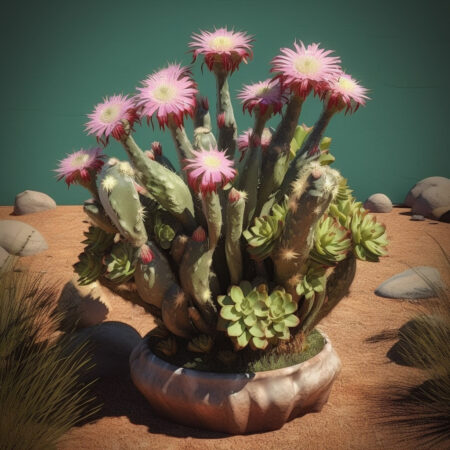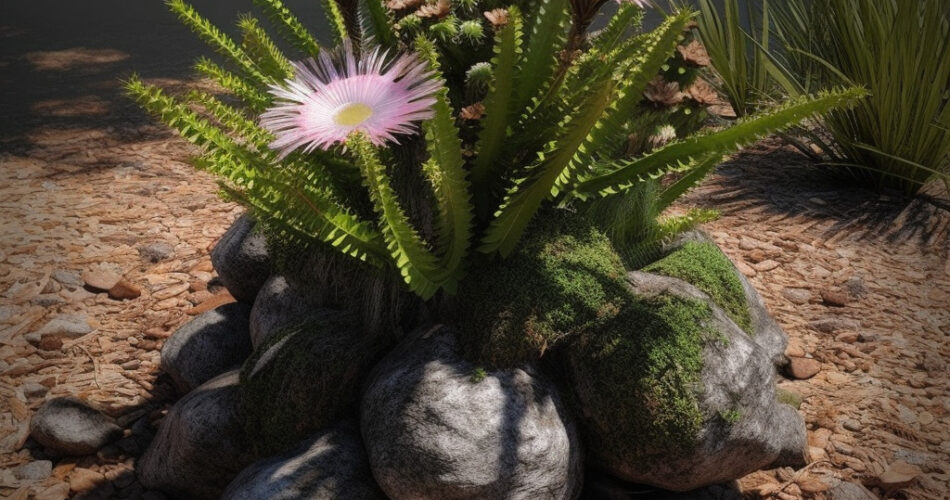Key Takeaways:
- This particular cactus genus stands out for its architectural elegance and array of flower colors such as red, white, pink, orange, and yellow.
- Adaptations like substantial water retention, defensive spines, and moisture-conserving skin ensure their survival in challenging desert conditions.
- The journey of this genus dates back to millions of years, with its evolutionary roots tied to the Miocene epoch, approximately 10 million years in the past.
- Originally from South America’s diverse terrains, especially the Andes, they’ve since found homes in various global locations from rocky terrains to indoor settings.
- This cactus genus reproduces through both sexual and asexual means. They attract pollinators for cross-breeding, and asexually, they produce offsets or ‘clones’ around the main plant.
- Cultivating these plants at home requires specific soil blends, controlled sunlight, and moderate watering. Interestingly, reviving a dehydrated one is simpler than one drenched in excess water.
- When nurturing these plants, common challenges faced include sunburn, excessive moisture leading to root decay, and pest issues. Striking the right balance in care is pivotal for their well-being.
Delve into the spellbinding universe of Echinopsis, a genus of cacti that is as astonishing as it is diverse. From its origins to its unique reproductive processes, this guide will unveil the mesmerizing aspects of this incredible cacti genus. Whether you’re an enthusiast or a curious reader, this guide will also offer a comprehensive overview on how to nurture your very own Echinopsis haven at home.
Unfolding the Echinopsis Enigma: A Peek into Its Distinctiveness
The Bizarre Beauty of Echinopsis: Not Your Average Cacti
Echinopsis, often called Penis Cactus, boasts an unparalleled beauty that is an amalgamation of harmonious symmetry, defensive spines, and a burst of radiant blooms. Its uniqueness lies in its dual nature: a sturdy exterior that belies a heart capable of producing some of the most stunning floral displays. The Echinopsis genus encapsulates a myriad of species, each offering its own set of magnificent flowers. These can range from the fiery reds and the calming whites to the pastel pinks and sun-kissed oranges. Some even surprise with a kaleidoscope of colors, blending two or more shades, and to add to this visual feast, many are accompanied by an intoxicating aroma.
A Secret World in Desert Shadows: Echinopsis Ecological Adaptations
Beyond their visual appeal, Echinopsis cacti are masters of endurance, having developed a slew of ingenious strategies to thrive in their arid homes. Their thick, bulbous stems act as reservoirs, capable of holding copious amounts of water, ensuring their survival during prolonged dry spells. Acting as a shield, their formidable spines not only deter would-be herbivores but also cast a shade over their bodies, reducing the impact of the scorching sun. Their skin, coated in a waxy layer, further aids in moisture retention, minimizing water loss due to evaporation. In a dance choreographed by evolution, many Echinopsis species bloom when the sun dips, unveiling their floral wonders under the moon’s soft glow. This nocturnal behavior is no coincidence; it’s a call to the creatures of the night, ensuring their pollination in an environment where diurnal pollinators are sparse.

The Echinopsis Odyssey: An Evolutionary Timeline
Parallel Universe in a Cactus: Evaluating Echinopsis Phylogeny
From the dawn of its existence, Echinopsis has been an emblem of resilience, continually adapting and reinventing itself in the face of Earth’s ever-shifting landscapes. Its phylogenetic tale, rooted in the ebbs and flows of ecological and climatic changes, provides glimpses into a dynamic evolutionary path.
Dating back to the Miocene epoch, a time when the world was undergoing significant transformations, the Echinopsis lineage was busy chalking out its own course.
Molecular footprints give credence to the theory that this genus stands as a shining beacon in the ‘recent’ radiations within the cacti lineage, having diverged to form its distinctive lineage nearly 10 million years ago.
Cacti Chronicles: Tracing the Historical Distribution of Echinopsis
Peeling back the layers of time, one can chart the ancestral journey of Echinopsis from the high plateaus and fertile valleys of South America. Born in the shadows of the Andes, Echinopsis ventured into different terrains, from steep altitudes to sprawling lowlands, each time tweaking its genetic code to better fit its surroundings.
This impressive adaptability has paved the way for its present global distribution. While its heart may still beat for the rocky outcrops and arid expanses of its homeland, Echinopsis has found admirers in every corner of the globe, be it in desert sanctuaries, terraced gardens, or the cozy confines of an indoor setting.
Mysteries Unearthed: Unveiling the Echinopsis Reproduction Tactics
The Seduction Game: How Echinopsis Blossoms Lure Pollinators
In the grand theatre of nature, Echinopsis plays a captivating role, weaving a tapestry of color, aroma, and nectar to enthrall its pollinators. As dusk falls, the Echinopsis blossoms unfold, emanating an enchanting fragrance that wafts through the night.
This aromatic symphony is not merely a spectacle but a siren call to moths, bees, and bats, beckoning them towards the rich nectar stores. As these pollinators flit from flower to flower, they unknowingly play cupid, facilitating the union of male and female gametes, ensuring the perpetuation of the Echinopsis lineage.
Greener Genes: Echinopsis Sexual and Asexual Propagation Phenomena
Within the reproductive arsenal of Echinopsis lies a dual mechanism, allowing it to capitalize on both sexual and asexual means. While its flowers engage in the intricate dance of pollination, the base of the plant busies itself in cloning operations. Here, small offsets, mirror images of their parent, emerge.
These offspring, though borne without the interplay of pollen and ovules, are every bit as robust and genetically equipped as their counterparts. They can be gently separated and given a new patch of land to conquer, continuing the endless cycle of growth and regeneration.
Gardener’s Paradise: Cultivating Echinopsis at Home
Green Thumb Guide: Best Practices for Growing Echinopsis
Echinopsis, with its radiant blooms and robust nature, makes a captivating addition to any gardening collection. When you decide to invite this desert gem into your home, it’s imperative to understand its native habitat to replicate similar conditions. Here’s how:
- Soil Composition: Echinopsis thrives in well-draining soil, which mimics its natural desert environment. To create an ideal mixture, combine regular potting soil with added pumice, perlite, or coarse sand. This blend ensures swift drainage, reducing the risk of root rot.
- Sunning and Shading: While Echinopsis basks in sunlight, remember its native habitat includes dappled shade from other desert vegetation. Thus, while they relish a good sunbath, during the fiercer summer months, a light shade can shield them from potential sunburn.
- The Watering Wisdom: Desert plants, Echinopsis included, have mastered the art of water conservation. Emulate this by watering sparingly. If in doubt, err on the side of caution; an under-watered cactus can bounce back with some TLC, but reversing the damages of overwatering is trickier.
Echinopsis Woes Debunked: Troubleshooting Common Gardening Pitfalls
Embarking on the Echinopsis gardening adventure is usually smooth sailing, but even the most seasoned gardeners might encounter a hiccup or two. Let’s debunk some of these potential pitfalls:
- The Sunburn Snafu: Just as we can get sunburnt, so can our prickly friends. If the plant’s skin appears bleached or reddish, it might be receiving too much direct sunlight. Relocate it to a slightly shadier spot or consider using a shade cloth during peak hours.
- The Water Worry: Overenthusiastic watering can drown the roots, leading to the dreaded root rot. Signs include a mushy base or discoloration. Prevention is the best cure: ensure proper drainage, and let the soil dry out between watering.
- Pest Patrol: Vigilance is your best defense against pests like mealybugs. These tiny white critters can cluster around the base or crevices of your Echinopsis. A soft brush or a gentle spray of water can dislodge them. For more stubborn infestations, consider insecticidal soap or neem oil.
Gardening is as much science as it is art. By understanding the unique needs of Echinopsis and responding to its subtle cues, you’re well on your way to creating a thriving desert oasis right at home.
FAQ
Where do these cacti originate from?
Answer: They originated from the highlands and lowlands of South America, particularly the Andes. Over time, these plants have adapted to various habitats across the globe.
How do they adapt to desert environments?
Answer: These cacti have developed several survival mechanisms for desert environments, including a large water storage capacity, protective spiky armor, and a waxy skin that reduces water loss.
What are common cultivation issues faced?
Answer: Common issues when growing these plants include sunburn, over-watering leading to root rot, and pest invasions such as mealybugs. Balancing care and attention is essential for maintaining a healthy plant.
How does their sexual reproduction occur?
Answer: Sexual reproduction is characterized by the attraction of pollinators for cross-fertilization. Pollinators, drawn by the bloom’s fragrance, transfer pollen from the stamen to the pistils while feeding on nectar.
In what colors do their flowers bloom?
Answer: Their flowers bloom in an array of hues including red, white, pink, orange, and yellow. Each species offers a unique floral allure, often accompanied by a delightful fragrance.
What is involved in asexual propagation?
Answer: Asexual propagation involves the creation of offsets or smaller clones around the base of the parent plant. These can be easily detached and replanted, growing into a new version of the parent.
What characterizes their beauty?
Answer: The beauty of these plants is a blend of their architectural form, spiky armor, and vividly-colored flowers, making them a standout in the cacti family.
How can one recover an under-watered plant?
Answer: To aid recovery, gradually increase the frequency of watering, ensuring the soil dries out fully between sessions. It’s generally easier to revive an under-watered plant than one that’s been over-watered.




Comments